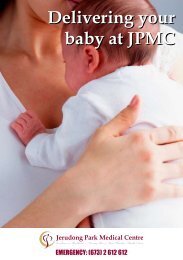Diagnostic Imaging - Jerudong Park Medical Centre
Diagnostic Imaging - Jerudong Park Medical Centre
Diagnostic Imaging - Jerudong Park Medical Centre
You also want an ePaper? Increase the reach of your titles
YUMPU automatically turns print PDFs into web optimized ePapers that Google loves.
How common is Osteoporosis ?Osteoporosis is responsible for more than 1.5million fractures worldwide annually. Ten millionindividuals already have osteoporosis, and 18million more have low bone mass. Approximately80% of those affected by osteoporosis are women,putting them at increased risk for fracture.A collapsed vertebra may initially be painless, orit may be felt as severe back pain. Later, the patientmay experience loss of height, spinal deformities, orstooped posture.For many women, osteoporosis is a silent disease thatdevelops with few warning signs.After menopause, the bones in the body may becomethinner and weaker. Over time, bone loss can lead toincreased risk of fractures.Each year, there will be more osteoporotic fractures inwomen than strokes, heart attacks, and breast cancerscombined.Up to half of women over 50 years old will breaka bone due to osteoporosis in their lifetime.SymptomsOsteoporosis is often called the “silent disease”because the loss of bone can occur without symptoms.Many women may not even know that they haveosteoporosis until they suffer a fracture. Even whena bone is fractured, the patient may not immediatelyrecognise the true nature of her condition.26 • Radiology Peripheral QCTRisk factorsThe more bone mass you have at age 30-35, the lesslikely you are to develop osteoporosis. There are manyfactors that determine how much bone mass you willhave - genetic, nutritional, and environmental. Whileyou may have control over some of these, e.g., calciumintake, you cannot change most of these factors.Certain people are more likely to developosteoporosis than others. Factors that increase thelikelihood of developing osteoporosis are called“risk factors.” These include:• Being female• Thin and/or small frame• Advanced age• A family history of Osteoporosis• Being postmenopausal, including early orsurgically-induced menopause• Abnormal absence of menstrual periods(amenorrhea)• Anorexia nervosa or bulimia• A diet low in calcium• Use of certain medications, such ascorticosteroids, thyroid replacement therapy,and some anticonvulsantsRadiology Peripheral QCT • 27













